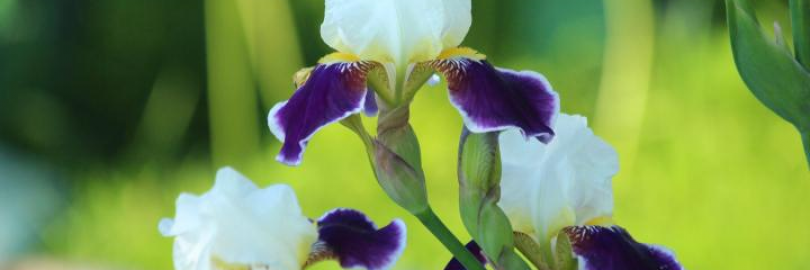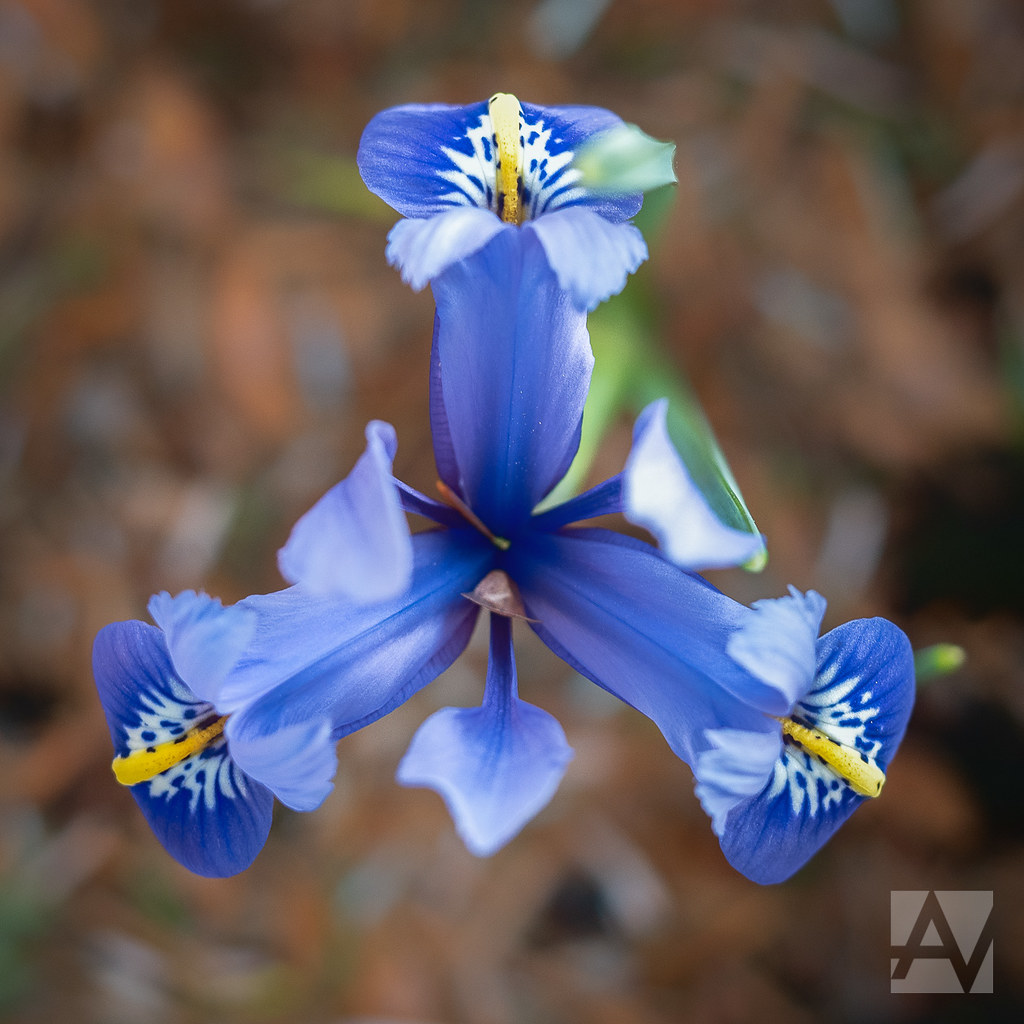
How to Care for Iris Flowers | Planting, Growing & Caring Tips
Iris Plant Overview
There are approximately 280 species of irises in the world. The majority of them are native to Europe and Asia. Unlike many other perennials, Irises are happy to bloom lavishly over a very wide area of North America. They are hardy into Canada, and are equally beautiful in gardens in places like Dallas, Texas, and even further south. Even though the imported garden irises are very beautiful, the 28 iris species native to the United States are beautiful in their own right. The most commonly planted iris in the United States is the bearded iris.
Iris are generally easy plants to grow in the garden and most of them take very little maintenance work. Except for the iris borer, pests are not a big concern. With careful selection, you can have iris blooming from early spring to mid-summer.
Most irises flower in early summer. Some - mostly bearded hybrids - are remontant, flowering again later in the summer. Irises attract butterflies and hummingbirds, and make lovely cut flowers. For iris companions in the garden, look to roses, peonies, and lilies.

Some Interesting Facts about Iris
1.The Iris was named after the Greek goddess who is considered to be the messenger of love and uses the rainbow to travel. Iris was probably named after the goddess because of the numerous colors it is available in.
Irises are among the best-known and loved among garden plants. Irises are hardy herbaceous perennials.
A flower on the Sphinx is considered to be an Iris, and another appears on a bas-relief of the time of the 18th Egyptian dynasty.
The Iris was also a favorite flower of the Moslems who took it to Spain after their conquest in the 8th century.
As a symbol of the French royal family, Iris has been almost a thousand years from the time of the Frankish kingdom to the Bourbon dynasty. Golden iris flower symbolizing the French royal family.
Types of Iries
Irises are classified into two major groups, Rhizome Irises, and Bulbous Irises. Within those groups are countless species, varieties, cultivars, and hybrids, according to the American Iris Society. Irises are classified into two major groups - Rhizome Irises, and Bulbous Irises. Within those groups are countless species, varieties, cultivars, and hybrids, according to the American Iris Society.
1、Rhizome Irises are thickened stems that grow horizontally, either underground or partially underground. After planting, iris rhizomes produce sword-like leaves that overlap, forming flat fans of green foliage. Three popular irises in this group are Bearded, Beardless and Crested Irises.
The bearded iris has four distinct parts: the Standards, Falls, Stigma flaps, and Beard. Bearded Irises have been popular forever, and no wonder. They are very easy to grow, and, especially in recent years, put on one of the truly great flower shows in the garden. Bearded Iris bloom is in “late spring,” after the tulips and daffodils, and often with oriental poppies and peonies.

The beardless variety has Standards, Falls and Stigma flaps, but usually, have crests. The Beardless Group includes pretty much the rest of the irises, and that means several kinds: most importantly Japanese, Siberian, Louisiana, and certain Species (or Wild) Irises. As you can tell by the names, beardless irises occur worldwide. They also require certain growing conditions.
The crested Irises or Evansia Iris has Standards, Falls and Stigma flaps and in addition to a ridge on the falls of the blossom, they have ridges like crests instead of beards. Crested irises are often considered in the same manner as the beardless iris. These plants spread freely by underground stems and produce flat flowers in the shades of blue, violet and white. Often the flowers and leaves are found on bamboo-like stems which can vary in height from 5-200 centimeters in height.

2、Bulbous irises grow underground from round or pear-shaped bulbs and are noticeably smaller than rhizome irises, usually both in plant and flower size. Two common types of bulbous iris are the Reticulata (early spring bloomers) and the Dutch bulbous(mid-summer bloomers.) Bulbous irises need a period of dormancy after they finish blooming wherein the plants rest and replenish for the next season.
If you like online shopping , don't forget to sign up at Extrabux.com!(What is Extrabux) , then you can enjoy up to 30% cashback on your order from Extrabux! Sign-Up Bonus: Free to join it & get $20 welcome bonus!
Popular Varieties of Iries
Japanese Iris
Because of their flower form and amazing colors, Japanese irises have been likened to oversized fluttering butterflies. Japanese Irises form large lavish hardy clumps and are highly decorative. They're also great for cutting. The Japanese iris demands constant moisture, full sunlight, and rich soil, so these plants would make a good addition to pond or stream side garden. Then, make this the season you start the Japanese iris garden you'll enjoy for countless future summers.

Siberian Iris
Gardeners new to irises will love easy Siberian irises. Unlike Japanese iris, the Siberian iris is very drought tolerant, and may succumb to crown rot if the soil stays too moist. They are suitable for borders, wild gardens, and along edges of ponds. Most Siberian iris flowers are blue, violet, or purple, and petals may be very ruffled. Siberian Iris are among the easiest of all types of Iris to raise and bloom in the temperate climatic zones. Their graceful stems, blooms, foliage, and neat habit of growth make them the most adaptable Iris for the perennial border and for landscaping.

Blue Flag Irises
This perennial plant is 2-3' tall. Both the flowering stalks and pedicels are terete and glabrous. Each pedicel is enfolded by a pair of sword-like spathes that become chaffy with age. Several showy, purple-blue blooms appear from the end of May to early July. The preference is wet to moist conditions, partial to full sun, and a rich organic soil. In light shade, this plant often fails to flower, and it tends to decline in abundance if conditions become too dry. To maintain the viability of the seeds, they should not be allowed to dry out – store them with some moist sand.

Louisiana Iris
The Louisiana iris, a small group of five species, is a good choice for gardeners who love the look of a day lily, but are frustrated by the color limits of the day lily family. As the name hints, the Louisiana iris is from the Gulf Coast area and prefers the mild temperatures, moist spring weather, and slightly acidic sandy soil found in that area.

Dwarf Crested Iris
Iris cristata, the native dwarf crested iris, has a special appeal to woodland gardeners, as it requires partial to full shade for healthy growth. The six-inch tall flowers appear from March to May, and will attract hummingbirds and bees to the garden. Provide an acidic soil to mirror the conditions of the pine groves where plants grow in the wild.

How to Care for a Iris Plant?
Planting Season
Plant irises in mid-to late summer (July to September/October) when nighttime temperatures remain between 40 and 50 degrees Fahrenheit or above. This gives them plenty of time to get established before the coming winter. The tall bearded irises are best planted closer to the fall because they go dormant in June.
Where to plant
Varieties suitable for zones 3-9. A southern exposure usually provides sufficient sun, especially if the bed is located near a wall or fence that can reflect sunlight back onto the plant. Raised beds are ideal for growing irises, as they provide the good drainage needed.
Sunlight
Plant them in a sunny spot in late summer. The plants need well-drained soil and at least six hours of sunlight per day. A full day of sun is even better to keep the rhizomes dry.
Water
Do not overwater irises. Water only if it is extremely dry or after transplanting. Too much moisture in the soil can cause the rhizomes (roots) to rot. Water consistently and deeply, especially during summer drought. Louisiana, Siberian and Japanese irises need a little more water than the bearded types.
Soil
Most irises prefer fertile, neutral to slightly acidic soil. Good drainage all year-long is very important. Iirises prefer "wet feet, but dry knees". They will not tolerate wet soil in wintertime. Avoid heavy clay soil and instead select garden sites with loam or slightly sandy quick-draining soil. Do not mulch. Mulching retains moisture, and too much moisture will cause a soft rot of the rhizomes. However, Japanese irises prefer lime-free soil.
Fertilizing
She applies a granular fertilizer twice a year-in early spring and just after bloom when the rhizomes are forming the next year's flowers. Irises don't require high levels of fertilization, adding some nutrients before planting improves the plant's growth. Working in a 2-inch layer of compost improves drainage and supplies some nutrients for the irises. Spread ½ pound of 5-10-5 fertilizer over every 50 square feet of bed. Reblooming Irises perform best if fertilized again after the first wave of flowering is finished.
Deadhead
(Remove spent blooms) consistently; Bearded Irises will flower sequentially on buds spaced along the stems. After blooming is finished, cut flower stems down at their base.
Dividing
Rhizomatous types need to be divided every 3-5 years, typically soon after bloom time. A reduction in blooming or rhizomes being pushed up out of the soil can be signs that it's time to dig them up and divide. Dividing irises is easy, and should be done after bloom. Simply dig up the whole mass of roots, and cut the rhizomes apart with a sharp knife. Then replant them, either singly, or maybe in small clumps a few inches apart - and transfer your "extras" to other parts of the garden.
If you want to find more deals on Iris plants, you can visit Burpee Gardening; edenbrothers.com; walmart.com; homedepot.com with up to 8% cash back from Extrabux!

Extrabux is an international cashback shopping site, offering up to 30% cashback from 10,000+ Stores!
B&H Photo Video, Dyson, Woodland Direct, Ooni UK, Bed Bath and Beyond, TUSHY, Zoro, Anthropologie, 4seating.com, GDF Studio, simplehuman, Appliance Parts Pros, etc.
Join to get $20 welcome bonus now! (How does Welcome Bonus work?)
Recommendation
-

Apple Watch Ultra 2 Real vs. Fake Guide 2025: How To Tell Original From Fake?
-

Microsoft 365 A1 vs. A3 vs. A5: Full Comparison & Verdict 2025
-

Is Turkish Airlines Good for International Flights?
-

Top & Best 12 Sneaker Apps/Websites for Raffles, Releases & Restocks in 2025
-

7 Best Gift Card Exchange Sites - Buy, Sell and Trade Discount Gift Card Safely and Instanly!











